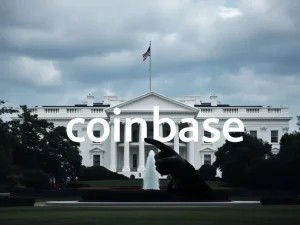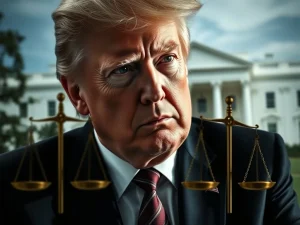US Crypto Policy Unveils Crucial Legislative Battles as Congress Returns

The halls of power in Washington D.C. are buzzing once more. After a month-long break, the US Senate and House of Representatives have returned to session. This marks a critical period for the cryptocurrency and blockchain industry. Lawmakers now face a demanding agenda, including key policies that will shape the future of US crypto policy. The stakes are undeniably high for investors, innovators, and the broader digital asset ecosystem.
Shaping Crypto Market Structure: A Key Priority
One of the most pressing items on the legislative agenda involves establishing clear crypto market structure. Republicans, particularly in the Senate, prioritize this issue. They aim to move a market structure bill out of committee and onto the floor for a vote. This effort follows the House’s passage of the Digital Asset Market Clarity (CLARITY) Act in July. That bill received bipartisan backing, with 78 Democrats supporting it. It now awaits further consideration and potential amendments in the Senate.
Wyoming Senator Cynthia Lummis is a prominent voice advocating for clearer crypto regulations. She has actively championed market structure legislation. During an August blockchain conference, Senator Lummis shared her optimistic outlook. She speculated that the Senate Banking Committee would pass its version of market structure legislation by the end of September. This bill would build upon the existing CLARITY Act. Furthermore, the Senate Agriculture Committee might consider it in October. Senator Lummis even predicted the bill could reach President Donald Trump’s desk before the year concludes. However, as of publication, neither committee had announced specific hearings for the bill.
Establishing a robust crypto market structure is vital for several reasons. It provides regulatory certainty, fosters innovation, and protects consumers. Currently, the lack of clear rules creates ambiguity for businesses and investors alike. A well-defined framework could:
- Clarify the roles of different regulatory bodies.
- Define how digital assets are classified.
- Set standards for exchanges and trading platforms.
- Encourage mainstream adoption of cryptocurrencies.
Such legislation would offer a much-needed foundation for the rapidly evolving digital asset space. It helps both traditional finance players and crypto-native companies understand their obligations.
The Critical Search for a New CFTC Chair
The Commodity Futures Trading Commission (CFTC) faces significant leadership changes. Starting Wednesday, Caroline Pham, a Republican, will become the sole remaining commissioner and acting chair. This follows the departure of Kristin Johnson, a Democratic member. Johnson announced her resignation plans in May, intending to leave before 2026. Pham has also indicated a move to the private sector if the Senate confirms Brian Quintenz as chair.
Quintenz’s nomination for CFTC chair remains uncertain. Despite Johnson’s impending departure and the CFTC operating with limited leadership, his confirmation is not guaranteed. Before the Senate’s recess, the Agriculture Committee delayed a vote on his nomination. This delay occurred at the White House’s request. This situation highlights the complex political dynamics surrounding key appointments in Washington.
Adding to the complexity, Gemini co-founders Cameron and Tyler Winklevoss reportedly pressured President Trump to reconsider Quintenz’s nomination. The Winklevoss brothers, known Trump supporters and donors, initially backed the nomination when Trump announced it in February. However, they later expressed concerns. They claimed Quintenz might not fully enact the president’s crypto agenda. This illustrates the significant influence external stakeholders can wield in the nomination process. As of Monday, the Senate Banking Committee scheduled consideration for five of Trump’s nominations on Wednesday. Yet, the Senate Agriculture Committee had not set a time for Quintenz’s confirmation. The role of CFTC chair is paramount for overseeing derivatives markets, which increasingly include certain digital assets. This leadership vacuum could impact future regulatory actions and enforcement.
Debating a Potential CBDC Ban in Defense Legislation
The House of Representatives successfully passed the Anti-CBDC Surveillance State Act in July. It did so with minimal Democratic support. However, Republicans are now exploring alternative avenues for its provisions. This standalone bill, aimed at preventing a central bank digital currency, was sent to the Senate for further consideration. The legislative path for a CBDC ban remains intricate and uncertain.
In August, the House Rules Committee shared a significant revision to HR 3838. This bill implements the National Defense Authorization Act (NDAA). The revised legislation controversially included a provision to ban the Federal Reserve from issuing a digital dollar. This directly mirrors one of the core tenets of the Anti-CBDC Surveillance State Act. Incorporating this provision into the NDAA represents a strategic move. It attempts to attach the CBDC ban to a must-pass defense spending bill. This tactic could increase its chances of becoming law. However, it also invites potential opposition from lawmakers who might support the NDAA but oppose the CBDC provision.
The debate around a central bank digital currency is multifaceted:
- Proponents often cite increased financial inclusion, faster payments, and greater control over monetary policy.
- Opponents, including many Republicans, raise concerns about privacy, government surveillance, and the potential for federal overreach.
It remains unclear which bill, if any, will garner sufficient support to pass through Congress without substantial amendments or modifications. The future of a digital dollar in the US hangs in the balance.
Navigating the Complexities of US Digital Asset Regulation
The return of Congress highlights the broader, ongoing efforts to define digital asset regulation in the United States. Lawmakers grapple with fundamental questions: How should digital assets be classified? Who should regulate them? What measures are necessary to protect investors without stifling innovation? These questions underpin the legislative initiatives currently underway. The CLARITY Act, the CFTC chair nomination, and the CBDC debate are all pieces of this larger regulatory puzzle.
The industry largely seeks clarity and consistency. Fragmented approaches from different agencies create confusion and compliance challenges. A comprehensive framework for digital asset regulation would provide stability. It could also position the US as a leader in the global digital economy. However, achieving bipartisan consensus on such a complex issue proves difficult. Different political factions hold varying views on the risks and opportunities presented by cryptocurrencies. The balance between fostering innovation and mitigating risks remains a central challenge for policymakers.
Key areas of focus for comprehensive regulation include:
- Consumer protection measures against fraud and manipulation.
- Clear guidelines for token issuance and trading.
- Taxation rules for various crypto activities.
- International coordination to prevent regulatory arbitrage.
The legislative process is often slow and deliberate. However, the rapid evolution of the crypto market demands timely and effective responses from regulators.
What’s Next for US Crypto Policy?
As Congress settles back into its legislative rhythm, the crypto community watches closely. The coming months will be pivotal for US crypto policy. Decisions made on market structure, CFTC leadership, and the future of a digital dollar will have lasting impacts. The path forward involves significant legislative hurdles, potential compromises, and ongoing debates. Stakeholders, from industry leaders to individual investors, must remain engaged and informed.
The interplay between the House and Senate, coupled with White House influence, will determine the final shape of these policies. The industry hopes for a clear, predictable regulatory environment. Such an environment would allow for continued growth and innovation. Conversely, a prolonged period of uncertainty could hinder development. Ultimately, the legislative outcomes will dictate the trajectory of digital assets within the United States. The focus remains on establishing a framework that supports technological advancement while ensuring market integrity and investor confidence.







